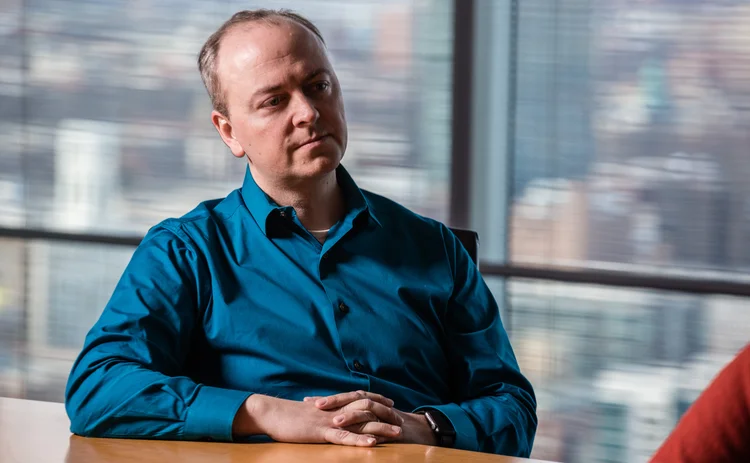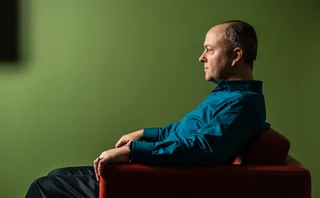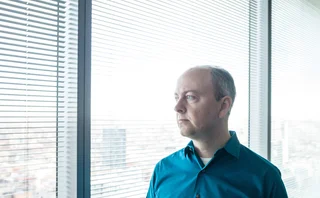Chicago Code: A Profile of DRW's Seth Thomson
Seth Thomson, CIO of DRW, talks to Waters about his career, innovation and how the firm has expanded into new asset classes, including cryptocurrencies.

Chicago has become the epicenter of bitcoin mania. The Chicago Mercantile Exchange and Cboe Global Markets were the first exchanges to launch bitcoin futures at the end of 2017. And one of the largest traders of cryptocurrencies is Chicago’s own DRW.
Since the firm launched in 1992, one of its key principles has been diversification. That’s where DRW’s chief information officer, Seth Thomson, comes into the picture. The Quantitative Risk Management (QRM) and Citadel alumnus joined DRW in July 2007. The firm was aggressively moving into the electronic trading space as Thomson arrived. That meant that it needed a new office, improved datacenters and an overhaul of its infrastructure.
“One of the biggest challenges here is maintaining diversification,” Thomson says. “We are trading so many things in so many ways that involve a lot of technology solutions and support. So one of our challenges is expanding in a scalable way that lets us grow and automating across that, but also not doing that to a point where we’re limiting innovation.”
It was those early projects that helped the company expand more quickly into new asset classes. So, while major investment banks were hemming and hawing at bitcoin—Goldman Sachs only just recently announced that it would start a crypto trading desk, UBS analysts have called cryptocurrencies the “bubble to end all bubbles”, and JPMorgan CEO Jamie Dimon called bitcoin a “fraud” before walking the statement back—DRW was able to jump out to an early lead, opening its desk for business back in 2014, when bitcoin reached then-heady heights of $1,100 per coin (in late 2017, a bitcoin was, at one point, worth over $19,000). Since then, its Cumberland digital currency trading desk has become a top market-maker, trading over $20 billion in bitcoin as of December, which was first reported by the Wall Street Journal and confirmed by Thomson.
While cryptocurrencies were the sexy investments of 2017, DRW has also built out its real-estate and venture-capital business units—in addition to its fixed-income, energy, agriculture, and equity-index futures and options desks, among others—and recently made three large acquisitions, with more potentially to come, according to Thomson.
“I have seen a big hunger from Don [Wilson, DRW’s CEO] and the partners to explore new opportunities,” he says. “We’ve never shifted in the decade that I’ve been here from a diversification approach and I think that’s what’s kept us very strong for 25 years.”
Kid Coder
When he was 11 years old, Thomson began coding his first video game in BASIC on a Commodore 64. It was a karate game, where all you could do was one kick—basic, indeed, but a beginning. In elementary school, his best friend’s father created and ran the computer lab at the local high school in Evanston, Illinois. The friends would buy computer magazines and do the coding examples together, and then play video games on an Apple IIe.
While he took those early skills with him to college, he wasn’t a computer science major. Rather, he first majored in psychology at Loyola University Chicago, because he wanted to better understand people—their interactions and personality traits.
This was in the early 1990s. To help work his way through college, he took a job at a local comic book store, Comic Relief (which perhaps hinted at his later profession), where he would buy and sell collectable comics to and from college kids looking for some extra beer money. It was fairly lucrative. He would buy $5,000 worth of comics for $500, and then sell those comics at a significant markup, all while building up his own inventory, which he still has (see ‘Comic Commodity’ at the bottom). Essentially, he was already a commodities trader, even as a psych major.
While in college, Thomson also began building white-box systems for gaming and general computer usage, which led him to consulting. He set up as an S corp.—an arrangement under US tax law that allows a single person to register as a corporate entity—with the name Imagination Unlimited, Inc., and while the acronym is the same as that of a fertility treatment, Thomson says, with a laugh, that the logo was cool. He then began working with small clients, such as high schools and accounting shops. During that time, he also studied for 18 certification exams while he was practicing his trade.
At face value, these backgrounds might seem disjointed, but combined they served as the base for his DRW career—an understanding of technology, business and how to communicate with people who have different personality traits. It’s what makes Thomson so valuable, Don Wilson tells Waters.
“Seth has been a key contributor to DRW’s growth over the past several years, and has been particularly strong for us in infrastructure planning and project and resource management,” Wilson says. “His leadership style has resonated with our technologists as he regularly helps them see the bigger picture, is a clear communicator, and makes time to mentor and encourage. One of his positive attributes is that he is continually adjusting our technology teams to meet the changing needs of the business, and that he leads with integrity and conviction that have garnered him the respect of his colleagues at DRW.”

Turning Pro
As Thomson’s tech career took off, he decided to take some time off from college to turn professional—he would eventually earn his BA in information technology and business management from DePaul University in Chicago. While his first salaried job was at an accounting software shop in 1998, in 2000 he moved into the world of trading, joining hedge fund giant Citadel, where he spent five years learning the capital markets. From there, he got a job at QRM as the fund’s director of IT services.
After two years at QRM, Thomson wasn’t looking for a career move, but then DRW—and Wilson—came calling in 2007. “We were a lot smaller when I joined DRW a decade ago, but we had a really big appetite and we were starting to get serious about electronic trading. That’s why I was approached,” Thomson recalls. “I was very happy at my last job, so I wasn’t fully committed to coming over to DRW just for the challenge. But Don asked me in my interview with him whether or not I would be eliminating politics and finger pointing as we grew my department. That really won me over,” Thomson explains, because he knew he could grow his team in a manner that he saw fit, with transparency and openness.
He joined DRW first as the firm’s director of IT services, responsible for core infrastructure. Over time, they moved other operational groups under his remit, from purchasing and facilities to project management and business analysis functions, at which point they made him CIO. Since then, he’s added middle- and back-office software engineering to his resume.
Teaching Kids to Code
One of Thomson’s greatest passions is exposing kids to coding at school and at home earlier in their development. He feels that as a society, we are not properly preparing our children for the jobs of tomorrow. Other industry experts agree. To read more on this societal issue, click here.
Chess Pieces
When Thomson joined DRW a decade ago, the IT services group consisted of fewer than 20 people, which he was tasked with growing four-fold rather quickly. Today, Thomson is responsible for a staff of about 170 across facilities, software and IT.
In addition to DRW growing its IT and datacenter footprints, it has also been heavily involved with acquisitions. In August 2017, DRW bought HFT shop RGM Advisors of Austin, Texas. Prior to that, in 2015, it nabbed Chicago rival Chopper Trading. And this last November, it closed the acqui-hiring of 10 traders, researchers and operations professionals from Houston-based energy firm Martin Energy Trading. Thomson says that more acquisitions are likely, but declined to provide greater detail.
Co-location, cutting-edge datacenters and speed matter in this business. DRW, along with the likes of Citadel Securities and Jump Trading, are at the top of Chicago’s HFT boom, so it’s fair to say that those areas have been—and will continue to be—well addressed, hence the acquisitions.
For DRW, it’s now about further improving automation and project management approaches. For instance, the firm has implemented a service-catalogue approach to more effectively tie assets to specific projects and needs. “It became pretty important early on to implement an allocations model that made sense,” Thomson says. “So we’ve implemented a pretty in-depth service-catalogue approach, where we describe all the different IT services we offer, and projects, and we tie all our work and all our assets to that. This way, any business can look at their costs and see what they’re getting and have a clear understanding of it, but also, we can attribute our work to things and I have metrics on our delivery.”
DRW also deploys a strategy where it mixes shared and embedded services. As such, a trading desk with a great need for bespoke software engineering will have software engineers sitting right on the desk. If it’s a desk with a lot of infrastructure needs that are continually changing to fit specific trading requirements, it will have people who will liaise with these groups and the liaison will talk to shared services to make sure that all needs are understood—and, crucially, that all of its infrastructure is well coordinated across trading desks.
The firm has also implemented custom co-location teams, formed security teams to protect against cyber threats, and has allowed various business units to create self-service applications, whereby traders and embedded engineers can set up their own dashboards using software that the IT group created in order to prevent bottlenecking for every little change.

DRW also uses “synthetic” project teams, where different members of different units are pulled out and then put together around a specific project. Upon completion of the project, they return to their original team.
This arrangement ensures that employees can work on many different IT projects, regardless of the focus of their specific team, provided they have the time to work outside of their core service, Thomson adds.
When it comes to development, Thomson says they are as “non-dogmatic” as possible.
“I will take different aspects from different things like ITSM [IT service management], DevOps, Agile and Scrum, and take what works best,” he says. On the infrastructure side of the company, you will see Python, PowerShell, legacy Perl, and C#. For its software products you’ll see Java, Ruby and languages like C++. And they’ll even play around with some newer languages and libraries, like Elixir and React. “We employ a ‘use the best tool for the job’ approach, while also being careful to scrutinize the cost of using a different methodology,” he adds.
‘The Goal’
A couple of years ago, Thomson oversaw a transformation of DRW’s Agile techniques in order to get more out of the firm’s engineers writing code. He had his infrastructure managers read Israeli business management guru Eliyahu Goldratt’s The Goal: A Process of Ongoing Improvement in order to help them identify bottlenecks in operations and find processes to automate. From there, they started to think about where they could write new code. It was a two-year project that culminated in the creation of a team of developers called infrastructure software services located within the core IT group. This group focuses on automation, but is also helping the firm’s other engineers to change the way they think about coding. “When we go to hire a network engineer now, we hire engineers with development experience. That’s been a major shift over the last 10 years,” he says.
Every financial institution will tell you they’re big on team building; those inside DRW might scoff at some of those claims. First, there’s DRW’s Speaker Series, which entails bringing in people to help generate new ideas and ways of thinking. Previous guests have included author Malcolm Gladwell, CNN’s Fareed Zakaria, and Reshma Saujani, who founded Girls Who Code. They also host “Geek Lunches” where they have both external and internal speakers deliver presentations on technology. Speakers here have included Scott Chacon, cofounder of GitHub; Brian Marick, author of Everyday Scripting with Ruby; and Jason Turner, a podcaster and C++ developer.
DRW also hosts an OpenSource OpenMic night, where local technologists are given five minutes to present something before they’re “gonged” off, Gong Show style. Then everyone goes downstairs to mingle. Finally, there’s the Geek Reading Group, which is essentially a book club for genuine mathematicians—one recent read was The Annotated Turing: A Guided Tour Through Alan Turing’s Historic Paper on Computability and the Turing Machine by Charles Petzold.
The idea is to create spaces for the sharing of ideas. As an example, during one Geek Lunch, DRW’s Network Engineering Development unit discussed its internally built network management platform. After they showed off their code, more developers started asking questions, trying to understand how the firm’s network traffic is handled and how they query the status of devices. As a result, the firm’s software engineers are now using some of the Network group’s tools, Thomson says.

Raise Your Hand
Thomson has spent a decade at DRW, largely because he feels comfortable speaking his mind with the firm’s partners. When he makes a mistake, he holds his hand up and takes ownership of it. In his early days at DRW, while his team was working to improve the firm’s power infrastructure, Thomson made an assumption about a technical issue they were having, but guessed incorrectly and the shop suffered an outage. He learned that he needed to deploy more people to look over his own work. He also went straight to Wilson, told him what happened, why it happened, and confessed his mistake. Wilson said, “OK,” and that was that.
As technology evolves and becomes more complex—as trading becomes increasingly electronic and faster, and as areas including machine learning, deep learning, distributed ledgers and quantum computing evolve—it is crucial to create an environment where technologists feel comfortable with making mistakes; they need to build an environment for learning, where errors can be worked out. You learn, you get better, you move forward, rather than suffering paralysis from fear and over analysis. That’s how you remain fluid in order to seize new opportunities, whether that be bitcoin, or the next big asset class.
Comic Commodity
Early in his college career, Seth Thomson was in theater and would do improv at local cafes in Evanston, Illinois. A customer approached him and asked him whether he wanted to host a talk show on cable access TV focused on comic books. The show, Comics Explored, ran for seven years. Its final episode—featuring that year’s Comic-Con convention—was even covered by the Chicago Tribune. “It was a positive review, but none of us wanted to do this for a living and it was starting to become a career, so we decided to end it like Seinfeld right there—go out on top,” Thomson says.
From that review: “Imagine Siskel and Ebert if, instead of movies, the tandem had gotten way, way into comics, and you’ll have an idea of what this endearing homespun show is all about. Cory Tadlock (the goateed one) and Seth Thomson (the ponytailed one) sit in a studio decorated with little more than an Oriental rug and talk comic books for 30 minutes.” Yep, Thomson had a ponytail.
Today, Thomson’s most prized comic book possession isn’t a lone issue, but here’s what he had to say: He has two complete runs of Neil Gaiman’s The Sandman and the original X-Men series, going back to 1963.
While he’s stopped collecting—kind of—he’s gotten his two kids into comics and still reads anything by Gaiman and is a big fan of Marvel mainstay Brian Michael Bendis. But, as he says, he’s no longer “dealing in volume.” That effort, instead, is reserved for the trading floor.

Only users who have a paid subscription or are part of a corporate subscription are able to print or copy content.
To access these options, along with all other subscription benefits, please contact info@waterstechnology.com or view our subscription options here: http://subscriptions.waterstechnology.com/subscribe
You are currently unable to print this content. Please contact info@waterstechnology.com to find out more.
You are currently unable to copy this content. Please contact info@waterstechnology.com to find out more.
Copyright Infopro Digital Limited. All rights reserved.
As outlined in our terms and conditions, https://www.infopro-digital.com/terms-and-conditions/subscriptions/ (point 2.4), printing is limited to a single copy.
If you would like to purchase additional rights please email info@waterstechnology.com
Copyright Infopro Digital Limited. All rights reserved.
You may share this content using our article tools. As outlined in our terms and conditions, https://www.infopro-digital.com/terms-and-conditions/subscriptions/ (clause 2.4), an Authorised User may only make one copy of the materials for their own personal use. You must also comply with the restrictions in clause 2.5.
If you would like to purchase additional rights please email info@waterstechnology.com
More on Emerging Technologies
Bloomberg rolls out GenAI-powered Document Insights
The data giant’s newest generative AI tool allows analysts to query documents using a natural-language interface.
Tape bids, algorithmic trading, tariffs fallout and more
The Waters Cooler: Bloomberg integrates events data, SimCorp and TSImagine help out asset managers, and Big xyt makes good on its consolidated tape bid in this week’s news roundup.
DeepSeek success spurs banks to consider do-it-yourself AI
Chinese LLM resets price tag for in-house systems—and could also nudge banks towards open-source models.
Standard Chartered goes from spectator to player in digital asset game
The bank’s digital assets custody offering is underpinned by an open API and modular infrastructure, allowing it to potentially add a secondary back-end system provider.
Saugata Saha pilots S&P’s way through data interoperability, AI
Saha, who was named president of S&P Global Market Intelligence last year, details how the company is looking at enterprise data and the success of its early investments in AI.
Data partnerships, outsourced trading, developer wins, Studio Ghibli, and more
The Waters Cooler: CME and Google Cloud reach second base, Visible Alpha settles in at S&P, and another overnight trading venue is approved in this week’s news round-up.
Are we really moving on from GenAI already?
Waters Wrap: Agentic AI is becoming an increasingly hot topic, but Anthony says that shouldn’t come at the expense of generative AI.
Cloud infrastructure’s role in agentic AI
The financial services industry’s AI-driven future will require even greater reliance on cloud. A well-architected framework is key, write IBM’s Gautam Kumar and Raja Basu.








